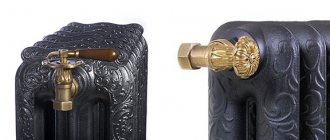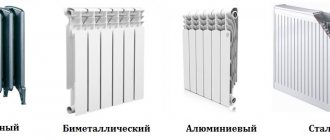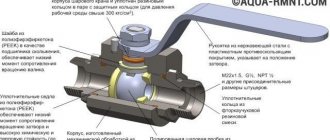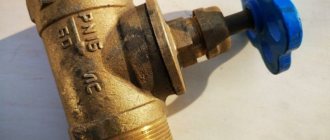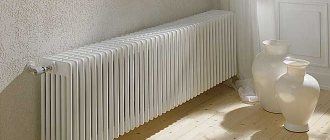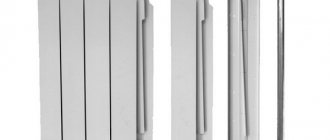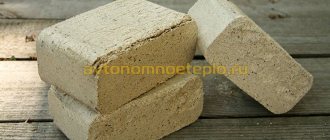In modern heating systems of private houses or apartments, shut-off and control valves are almost always installed on the connections to radiators. Previously, batteries were usually connected directly to risers and this fact did not upset anyone. However, since then, priorities have changed, and every homeowner has become imbued with the need to save energy. Why install taps for heating radiators, how installing fittings relates to savings and which products are best to choose for this purpose will be discussed in our material.
Technical features of radiator taps
Valves for heating radiators are valves installed on heating pipes and serving as a shut-off system. Their main feature is to block the access of hot liquid to the battery.
Therefore, if the heating system malfunctions, there is no need to contact the housing and utility company to troubleshoot the problem. When the tap is closed, the water will not flow into the radiator itself, but will pass further along the pipe through the built-in jumper. The radiator will remain without liquid, which will provide conditions for its installation.
- Such devices are ideal for private households.
- If one of the batteries malfunctions, it will be enough to close the valve on it.
- At the same time, other radiators will continue to operate and the temperature in other rooms will not be affected.
Also, this feature of heating taps will help save the family budget; non-residential premises can be turned off from heating by turning off the tap on the radiator.
How to install a thermostat on a battery: step-by-step instructions
Unscrew the drive nut with an adjustable wrench and unscrew the old winding.
Clean the threads of the outlet so that the connection between the radiator and the pipe is clearly visible.
Perform the same operation with the lower connection. For ease of installation, remove the radiator and place it on a flat horizontal surface. Hold the radiator cap with one wrench and unscrew the tube with the second.
After this, remove the old seal from the hole, for example, with a screwdriver.
Now you need to assemble a bypass with a thermostat and a ball valve. Coat the threads of the compression fitting with silicone sealant until it fills all cavities.
Take 2 tees and 2 nipples and twist them together.
Screw the thermostat and ball valve to the nipple.
Install transition couplings from metal-plastic to metal into the tee. You should end up with a knot like this.
Screw it into the battery.
Do the same with the bottom connection.
For the bypass, cut off a section of metal-plastic pipe of the required length, after first removing the nuts from the compression fittings and measuring the distance.
Calibrate the edges, that is, remove the chamfers with a calibrator.
Place the nut and ferrule on the pipe and connect it to the ball valve and thermostat.
Do the same with the other end of the pipe. The jumper (bypass) is ready. Connect it to the radiator.
Hang the battery on the old mount and connect it to the riser. To do this, prepare 2 metal-plastic tubes. Don't forget to measure the length at the top and bottom - it often varies.
Remove the bypass from the radiator. Screw the tubes into the upper and lower nodes.
Install the bypass on the radiator, and the tubes in the riser outlets. At the top there is a thermostat for heating.
Below is a ball valve.
Tighten the nuts with an adjustable wrench. The radiator with thermostat can be put into operation.
Application
Valves on radiators are necessary primarily to shut off the liquid in them. Those. they serve as a locking system.
This gives them the following functionality:
- Turn off the heating system as needed;
- Shutting off the fluid in the system to carry out repair and maintenance work on the heating system;
- Regulation of air temperature depending on the preferences of the owner of the premises.
Often such cases occur in apartment buildings, when it is warm outside, but the heating has not been turned off or gas meters are installed throughout the entire building. Then it turns out, according to the colloquial expression, “they are drowning the street.”
The solution to this problem will also be a faucet on the radiator, which will help create not only a comfortable temperature in the room, but also save money.
Specifics of various cranes
The market offers two types of taps, starting with an automatic device and ending with equipment with thermal heads. Each of them has its own specific work.
Manual adjustable taps or valves of automatic devices are equipped with thermal heads, which allows you to save energy during the heating season. This is achieved due to constant air temperature in the rooms.
Moreover, the manual taps are designed in such a way that before the start of the heating season, it is possible to adjust the coolant according to one system, which will not allow the coolant to exceed the established norm.
As for valves equipped with thermal heads, where the fluid flow is automatically regulated. Due to this, the flow area in the heating system is reduced or increased, depending directly on the temperature in the room.
Installation nuances
Taps for heating radiators are used in the following cases:
- For central heating systems;
- For private housing construction and apartment buildings equipped with an individual heat source;
- For apartment buildings that belong to an individual boiler room.
Before installing valves or taps, you need to know that these devices block the cross-section of the pipe. Therefore, any regulation using these devices will reduce the heat supply to the radiators.
If there is not enough thermal energy, regulation of the battery taps is not necessary. This will only lead to cooling of the air in the room. Here, one option is to block the entire flow.
If the house is heated by a central boiler room, then it is recommended to install brass taps on the radiators. Valves with thermal heads will not help in this case, but will only clog the coolant control.
Then the only solution is high-quality installation of heating radiators. Also, with centralized heating, pressure surges and water hammer occur, which are caused by the startup of the heating system.
Therefore, it is recommended to install ball valves on radiators, which are designed for pressures of more than 16 bar. As for the material itself for making valves or taps, it is advised to purchase a product made from high-quality metals that will withstand any force of corrosion.
Valve or shut-off valve
The valve can be called the brother of the gate valve. The device is activated by turning the flywheel, which transmits an impulse to the spindle, which begins to move forward and at the other end the spool, equipped with a gasket, closes. If the valve closes, then reaching the lower position, it rests against the seat, as a result of which the liquid is blocked (locked). This is where the name comes from - shut-off valve. Shut-off valves are widely used in water and fuel systems. They are shut-off and regulating and are presented in a wide variety of appearance and design. The service life varies from 20 to 30 years due to the quality of materials and operating characteristics. Wear occurs when 8 thousand closed-open cycles have been completed.
The devices also have their advantages and disadvantages. The advantages are determined by its operational characteristics:
- smooth regulation of water flow
- maintainability (replacement of the spool gasket or stuffing box gasket with its tightening);
- the presence of a smaller number of rubbing parts, which provides the valve with an increase in service life;
- the use of valves when regulating the flow of water to several objects (you simply cannot do without them) water and heat supply.
Disadvantages are characterized by a decrease in performance properties due to:
- increased hydraulic resistance, creating a stagnation zone where suspended particles can accumulate, which can cause premature wear and corrosion;
- failure of the spool gasket (separation by liquid flow, sticking, drying out), which leads to frequent repairs;
- the need to maintain the valve device in working condition, for which it should be completely opened or closed at least once a year if there has been no load in operation for a long time.
The exception to the rule here is a direct-flow valve with an inclined spindle, where less resistance is created in the hydraulics. This is achieved by the oriented position of the seat towards the fluid flow.
Variety
These devices have significant differences from each other.
Device types:
- Ball equipment. Serves the battery without shutting down the entire heating system. The shut-off fittings are located between the pipe and the radiator. The equipment is made of metal, which includes a body part, a handle and a couple of pipe sections. The peculiarity of the device is that the faucet closes and opens the equipment. It does not apply to temperature control;
- Cone devices. They are manual control of the radiator temperature. The faucet is a metal body part equipped with a handle. The peculiarity of the device is that it reduces the heating of the radiator. The downside of the faucet is periodic cleaning of the device from deposits;
- Mayevsky's device. Used to reduce accumulated air and gas in the battery. It is a plug with a metal thread and a hole through which air and gas escape. These devices are ideal for radiators made of aluminum, because it is this metal that accumulates air and gases the most (they are removed once a month);
- Thermostatic taps. Represented by an automatic device. The valve consists of a cylinder filled with liquid and gas. The device itself has a temperature regulator that allows you to maintain a constant temperature in the room. Important! A radiator with such a device provides a bypass.
Criterias of choice
A radiator valve is, as a rule, a ball-type device that regulates water flow and connects pipes to the radiator. Installed on the bypass, risers, at the top of the battery, in places where air accumulates to bleed it.
Choosing a suitable faucet is not difficult, just know a few nuances:
- the diameter of the pipes to which it will be connected (DN, in millimeters or inches);
- working pressure (PN, in the range of 15–40 and above);
- type of connection, presence of thread inside or outside, American.
The choice should take into account the purpose of the reinforcement, its location, and the properties of the environment. The ratio of the input and output of the valve in the radiator and their relative position are also important.
When choosing, you should consider the characteristics of the cranes:
- Ball valves, although the most common and affordable, are not very effective. It has only two modes: closing/opening;
- a cone valve is a more acceptable option due to the possibility of an intermediate position. Disadvantage: the tap must be returned to its original position and constantly monitored;
- An automatic thermostat is the most efficient, reliable, but also much more expensive than others. When installing it on a one-pipe system, a bypass must be present.
Shape of taps
The devices are available in two types - angle and straight valves.
Direct device
A straight faucet delays the flow of coolant, reducing the cross section. At the same time, the throughput capacity is reduced by half compared to a pipe of this cross-section.
Angle valve for radiator
The device is located on the battery at an angle of 90 C. The throughput of the crane compared to the above-mentioned brother is increased a couple of times. All this is justified by the fact that the raised spool does not block the flow area of the device.
Where to buy and cost
The market offers more than 50 types of battery valves. They can be purchased in almost any department of a hardware store related to equipment for equipping thermal systems in private or apartment buildings.
Also, battery taps can be purchased in an online store, knowing only the composition of the heating system. Considering all these tips, questions about where to buy radiator taps will simply not arise.
The price of radiator taps depends on the following factors: the manufacturer of the product, the region where these products are sold, the metal of the tap itself and its functionality.
Using heating batteries in a private home
Heating boilers installed in private homes are usually equipped with programmable automation and a set of weather-dependent sensors. In this regard, there is no need to install separate taps for aluminum heating radiators on each device.
A sufficient measure in this case would be to install one valve on the supply pipe at the top point of the circuit and a shut-off valve on each device. Such a system makes sense from an economic point of view, since valves are much more expensive than valves. In addition, programmable boiler control allows you to achieve a similar effect.

